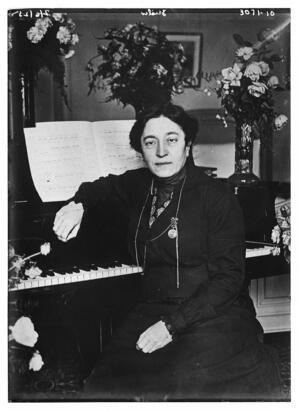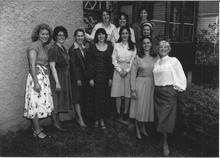Fannie Bloomfield Zeisler
Praised for “Playing like a man,” Fannie Bloomfield Zeisler exploded notions about women pianists with the precision, power, and expressiveness of her performances. Zeisler began studying piano in Chicago under the theorists Bernhard Ziehn and Carl Wolfson, making her debut at age eleven for Wolfson’s Beethoven Society. She studied in Vienna under Theodor Leschetizky, returning to America in 1884. Through marriage and children, Zeisler continued her demanding career, touring America and Europe, teaching at Chicago’s Bush Temple of Music, and performing up to fifty engagements per season. In 1925, she celebrated the fiftieth anniversary of her debut with the Chicago Orchestra. Towards the end of her career, Zeisler focused more on teaching than performing, passing her excellence onto young musicians, many of them women.
“She plays like a man” was a near-refrain in critiques of Fannie Bloomfield Zeisler, a brilliant pianist who emerged in the young, male-dominated American concert world of the 1880s. With magnetic energy and articulate technique, Zeisler broke out of the “lady pianist” molds to become a virtuoso revered for her musical intellect, expressivity, bravura, and scintillating touch in a wide range of concert repertoire. Her popularity peaked in the late 1890s, following highly acclaimed European tours, and continued into the first two decades of the twentieth century. Through much of her life the pianist juggled fifty-engagement seasons with teaching (at Chicago’s Bush Temple of Music and in a private studio) and family duties; in her fifties, her career began to subside, affected by deaths in her family and health setbacks.
Early life: from Austria to America
Fannie Bloomfield Zeisler was born on July 16, 1863, in Bielitz, Austrian Silesia, the youngest of three children of Bertha Jaeger and Salomon Blumenfeld. Her brothers were Sigmund and Moritz, later known as Maurice Bloomfield, a renowned Sanskrit scholar. In 1867, the four-year-old Fannie moved with her family from war-depressed Austria to Appleton, Wisconsin, where her father entered into a store partnership, then to Milwaukee, and, in 1870, to Chicago. In the family’s Chicago home, first located near the Blumenfelds’ dry-goods store in the city’s Jewish neighborhood, Fannie absorbed German Jewish values and traditions from her Term used for ritually untainted food according to the laws of Kashrut (Jewish dietary laws).kosher (kasher)-keeping grandmother Jaeger, her father, a Talmudic scholar, and her mother, an avid reader of German literature.
Early piano training
An intelligent and serious child, Fannie excelled in public school and early music study. She graduated with honors from Chicago’s Dearborn School for Girls, where she stood out as the only Jewish girl of her class. At seven, after being taught piano informally by her brother Moritz, she began three years of formal study with the theorist Bernhard Ziehn before working with the charismatic teacher Carl Wolfsohn. Following a debut at age eleven at a concert of Wolfsohn’s Beethoven Society on February 25, 1875, and reappearances with the organization, she auditioned for the touring Russian virtuoso Annette Essipoff in 1877 and, at her urging, set off for Vienna the following year to study with Theodor Leschetizky, accompanied by her mother and grandmother, and partially subsidized by local banker Henry Greenebaum. After one year at the Vienna Conservatory, Fannie began a rigorous course of study, lasting from 1879 to 1883, with Leschetizky. She became one of a luminous roster of pianists who would emerge from his studio.
Shortly after “graduation” performances in Vienna, Fannie returned to America and secured Henry Wolfsohn, brother of her early Chicago teacher, as her manager. Her American debut as a professional, on January 11, 1884, with Chicago’s Beethoven Society, was in essence a return engagement; her New York debut came on January 31, 1885, with a performance of Anton Rubinstein’s Concerto in D Minor conducted by Frank Van der Stücken. During the 1884–1885 season, she also appeared in a series of concerts with the Boston Symphony Orchestra under Wilhelm Gericke and the New York Symphony under Walter Damrosch.
Marriage, children, fame
On October 18, 1885, she married her second cousin, Sigmund Zeisler. Sigmund Zeisler had met the pianist during her early Vienna years and, after completing a J.D. at the University of Vienna, followed her to Chicago. He then earned an L.L.B. at Northwestern University before acting as defense cocounsel in the explosive trial of the Haymarket Riot “anarchists.” The couple had their first child, Leonard, in 1886, followed by sons Paul, born in 1897, and Ernest, born in 1899. The Zeislers maintained a German American home in which High German was spoken. Although they were nonpracticing Jews, both belonged to Jewish clubs, associated with prominent Jewish leaders and artists, and supported Reform Judaism.
Despite her husband’s wishes that she settle down to a domestic life, Zeisler returned to Vienna by fall 1888 for a five-month “refresher course” with Leschetizky. Her determination to excel paid off within the next decade, when she solidified artistic relationships with the orchestras of New York, Boston, Chicago, and Pittsburgh, performed at the Columbian Exposition of 1893, toured Europe, and appeared in numerous recitals throughout the United States, including an 1896 West Coast tour that featured seven different programs in eighteen days. Although “nervous prostrations” had cut short her first European tour of 1893–1894, her triumphs during this and the following season in Europe marked a career turning point. By 1896, American writers were dubbing her “America’s greatest virtuoso” and, at times, the “Sarah Bernhardt of the piano.” Zeisler performed in England in 1898 and returned to the Continent in 1902 and 1912.
Zeisler’s legacy
By the end of her career, Zeisler had appeared with major American and European orchestras under the prominent conductors Camille Chevillard, Walter Damrosch, Victor Herbert, Artur Nikisch, Anton Seidl, Leopold Stokowski, Richard Strauss, and Theodore Thomas. She had given regular solo recitals in major American concert halls, including annual appearances at Carnegie Hall, and had shared the stage with prominent concert artists. In addition to the then-standard concert repertoire, some of which she recorded for the Welte-Mignon and Ampico recording pianos, she promoted works of contemporary American and European composers. Two imposing programs put the final touches on an eminent career. In February 1920, in a single evening at Chicago’s Orchestra Hall, she overwhelmed her audience with three concertos (Mozart’s C Minor, Chopin’s F Minor, and Tchaikovsky’s B-flat Minor). She did a repeat performance at Carnegie Hall. On February 25, 1925, she celebrated the fiftieth anniversary of her early debut with performances of the Schumann A Minor and Chopin F Minor concertos with the Chicago Orchestra.
As performer and teacher, Zeisler was a central transmitter of Leschetizky’s high standards of pianism and artistry (preceding the Leschetizky-trained Paderewski on the American scene) and a widely publicized role model for two generations of young American musicians, many of them female. Her successes, built on her Viennese training, were buttressed by an uncannily strong will and by ideals of hard work and achievement instilled by her family.
Fannie Bloomfield Zeisler died of a heart attack on August 20, 1927, at age sixty-four. She was eulogized as a “truly great and noble woman” whose vigorous, intense life was filled with “idealism, indomitable courage, remitless industry, [and] absolute sincerity.”
Selected Works by Fannie Bloomfield Zeisler
“Appearing in Public.” In Great Pianists on Piano Playing, edited by James Francis Cooke (1913).
“Public to Blame for Blind Worship of European Fetish.” Musical America (October 1914).
“Woman in Music.” American Art Journal 58 (1891): 1–3.
Allais, Paul, Ella Snell Gara, Nellie Killiam, Rose H. Mergentheim, and Ernest Moeller. Fannie Bloomfield Zeisler Appreciation (1927).
Ammer, Christine. Unsung: A History of Women in American Music (1980).
Cohn, Harriet. “The Life and Career of Fannie Bloomfield Zeisler.” Research paper, University of Cincinnati (1960).
Cole, Rossetter. “Fannie Bloomfield Zeisler.” Studies in Musical Education, History and Aesthetics: Music Teachers’ National Association Proceedings 12 (1927): 76–78.
DAB.
Ehrlich, A. Celebrated Pianists of the Past and Present (1894).
Fay, Amy. “Fannie Bloomfi[e]ld-Zeisler,” Music 9 (1895): 224–225.
Ffrench, Florence, comp. Music and Musicians in Chicago (1899).
Gerig, Reginald R. Famous Pianists and Their Techniques (1974).
Hallman, Diana R. “Bloomfield Zeisler: American Virtuoso of the Gilded Age” (in progress), and “The Pianist Fannie Bloomfield Zeisler in American Music and Society.” Master’s thesis, University of Maryland (1983).
Lahee, Henry C. Famous Pianists of Today and Yesterday (1901).
Mathews, William S.B. “A Great Pianist at Home.” Music 9 (1895): 1–10.
New Grove Dictionary of Music and Musicians (1980), NAW.
Saville, Richard. “Madame Bloomfield-Zeisler.” Musician 9 (January 1904): 5.
Schonberg, Harold C. The Great Pianists (1963).
Tracey, James M. “Some of the World’s Greatest Women Pianists.” The Etude 25 (December 1907): 773.
UJE, s.v. “Fanny Bloomfield-Zeisler”.
Who’s Who in America (1899 and subsequent editions).
Zeisler, Sigmund. “Fannie Bloomfield Zeisler.” Biographical draft. AJA, Cincinnati, Ohio.




